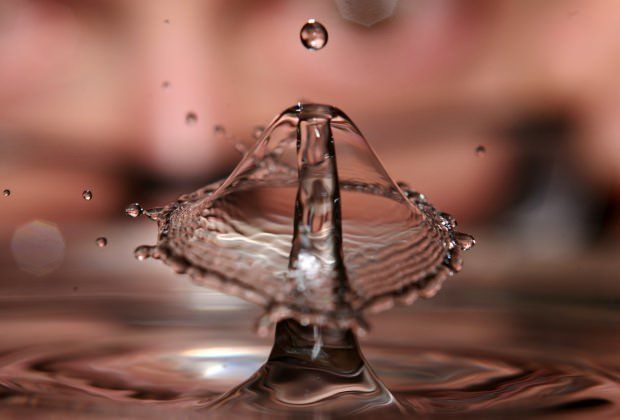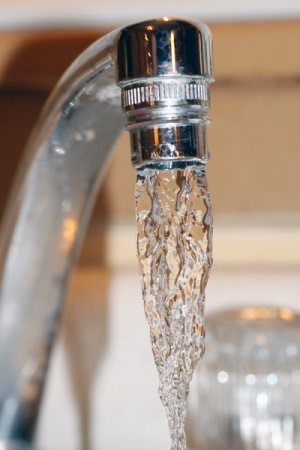
Think tap water is safe if it sits overnight?
You’re not alone. Yes, maybe this was true in the old days. But if you stick to the 24-hour rule now, you could be putting your goldfish at risk.
Why? Doesn’t chlorine evaporate after 24 hours?
It does. Though, with the addition of chloramine (what happens when chlorine and ammonia are bonded together), ammonia gets left behind even as the chlorine takes off.
With adequate filtration, this might not be a problem. But since goldfish add their own ammonia load to the water (and a hefty helping at that), your biofilter might have a hard time managing all that waste.
That’s why it’s always good to remove chlorine and ammonia from tap water. Lucky for goldfish, a tap water conditioner does just that.
Not only are water conditioners effective for neutralizing chlorine, many tackle this very chloramine problem to make the resulting ammonia completely harmless and safe for your goldfish.
The Magic of Magnetism: How a Tap Water Conditioner Works
If you didn’t think the chlorine problem could get any worse, you’re in for a shaky awakening!
If you just take tap water and pour it into an aquarium with live goldfish, invisible compounds in the water can actually burn your goldfish’s gills, attacking the cells in living tissue. The next thing you know, your goldfish are rushing to the top of the aquarium, frantically gasping for breath.
If the chlorine isn’t removed – and soon – death could quickly follow.

Water districts disinfect bacteria and pathogens with chemicals like chlorine and chloramine, making tap water safe for humans to drink. But these same chemicals are dangerous to pet goldfish.
Here’s when water conditioners come to the rescue.
A tap water conditioner works by neutralizing chlorine, forming ionic bonds and rendering the chlorine harmless. The tap water is then goldfish-friendly, completely safe for both goldfish and beneficial bacteria that keep your aquarium water healthy.
Think of it like this – harmful tap water is full of positive charged magnets called chlorine that magnetically stick to your goldfish’s gills. When you use a tap water conditioner, negative charged magnets get to work, attracting harmful disinfectants. Now, instead of clinging to fish gills, the chlorine magnets stick to the conditioner magnets and the chlorine becomes harmless (source).
Water conditioners that neutralize chlorine are all well and good. But if your public water system disinfects tap water with chloramine, you’ll need a tap water conditioner that can split apart the chlorine/ammonia bond and tackle each separately.
Since water districts often switch between chlorine and chloramine, it’s best to play it safe and purchase a tap water conditioner that deals with both.
Tap Water Conditioners: What Are My Options?
Not all water conditioners are created equal. Some only neutralize chlorine (but not chloramine), while others offer a full package of features (that you may not need).
There are three main types of water conditioners.
- Dechlorinators: Using small amounts of sodium thiosulfate, these basic water conditioners quickly and effectively remove chlorine but won’t even touch ammonia or heavy metals!
- Chloramine Neutralizers: These useful water conditioners not only get rid of chlorine, but they also tackle pesky ammonia and sometimes heavy metals as well.
- Complete Conditioners: Handy water conditioners that neutralize chlorine and ammonia, these conditioners also detoxify harmful heavy metals and remove copper from water.
It’s not uncommon to stumble across chloramine neutralizers and complete conditioners in the pet store.
Fancy water conditioners might also include additional vitamins to boost the immune system. Some even reduce stress by replenishing the slime coat (that slimy sheen covering the scales and protecting goldfish from infections), providing them extra defense against hazardous goldfish diseases.
Luckily, water conditioners are pretty inexpensive and last a while before you need to restock your cabinet.
How Often Is Enough? A Foolproof Water Treatment Plan
Always condition tap water when you first set up a new aquarium and during each partial water change.
- When setting up a new aquarium: If you’re just getting the nitrogen cycle started and haven’t yet added any goldfish (for fishless cycling), you can hold off on buying a complete tap water conditioner and instead use a simple dechlorinator. This way, when chlorine is neutralized, the leftover ammonia will be fed to the beneficial bacteria to jump start the nitrogen cycle.
- With every water change: Water added after the initial tank setup should be treated with a chloramine neutralizer or complete tap water conditioner. If you don’t use either one of these, you risk killing off all the beneficial bacteria – and that could crash the nitrogen cycle!
Once you’ve set up your goldfish tank, you’ll only really need a tap water conditioner every time you perform your weekly water changes.
2 Ways to Treat Tap Water: Bucket or No Bucket?
Water conditioners work their magic in literally minutes.
You can condition your tank water one of two ways: in a bucket or directly in the aquarium.
Cautious? Try a Bucket
Simply fill a bucket with tap water and measure in the right amount of conditioner!
It helps to have your own tank-friendly teaspoon for measuring. You’ll also need to know how large your bucket is (and how much water can fill it).
You should only need just enough water conditioner to treat the amount of water in the bucket. I like to swirl the water in the bucket before filling the tank (so I know the tap water conditioner is mixed well).
Skip the Bucket and Go All In!
If you use a hose or water changer that attaches to your sink faucet, you can condition tap water as you splash it directly into the aquarium.
In this case, you may need to measure the right amount of conditioner for the full volume of your tank (follow the directions on the water conditioner bottle). Slowly drip the right amount of tap water conditioner into the stream of water as you fill your aquarium.
It may help to swirl the water around the aquarium to mix the conditioner with the tap water.
Whatever method you choose, always treat tap water with a water conditioner.
Remember: just because tap water looks clean, doesn’t mean it is!
There could be harmful chemicals running rampant behind the scenes – many dangerous compounds are colorless, even odorless, and invisible to the naked eye. Never take crystal-clear water as a sign that the water is healthy or safe for your goldfish.
By keeping water quality high, your goldfish will live long, happy lives.
Keep conditioning tap water and maintain a healthy aquarium environment with adequate filtration and routine water changes. You should also run weekly water tests with a freshwater test kit to ensure the water stays in tip-top shape.
How about you? Which tap water conditioner do you use?




4 comments
I’m taking care of a goldfish for a friend. I went to pet store and got another goldfish for company. I also go a larger bowl…3.5 gallons of water and a rock with plastic plants. I put water and decoration in bowl. Added Start Right by Jungle. How long do I wait to put fish in new bowl? I also need to put the small pebble/rocks from old pitcher to new bowl…any advise would be appreciated. Thanks.
Hi Marty,
Most water conditioners work pretty quickly, so you can add your goldfish to conditioned water pretty much right away. If you’re worried, you can always swirl the water around a bit to ensure the water conditioner has conditioned all areas of the aquarium, before placing your goldfish in the tank.
However, two goldfish won’t be very happy in a 3.5-gallon bowl. Ideally, you’ll want a minimum of 30 gallons for the goldfish to thrive. Read more about this in my goldfish tank guide.
If you can’t afford a larger tank right now, you’ll need to be very diligent about water changes and testing. Test the water for ammonia, nitrite, and nitrate frequently – high levels of any of these water parameters can be very damaging to your goldfish. Keep ammonia and nitrite at 0ppm (parts per million) and nitrate below 40ppm. Make sure you have a filter in the aquarium! Your goldfish won’t survive without one.
And if a 30-gallon tank isn’t possible in the near future, get the largest size you can afford. Even a 20 or 10 gallon is better than a 3.5-gallon bowl. Eventually, you will want to upgrade to a 30-gallon tank though.
Thank you …!! So much for this article
You’re welcome, Samuel! Glad the information was useful. 🙂